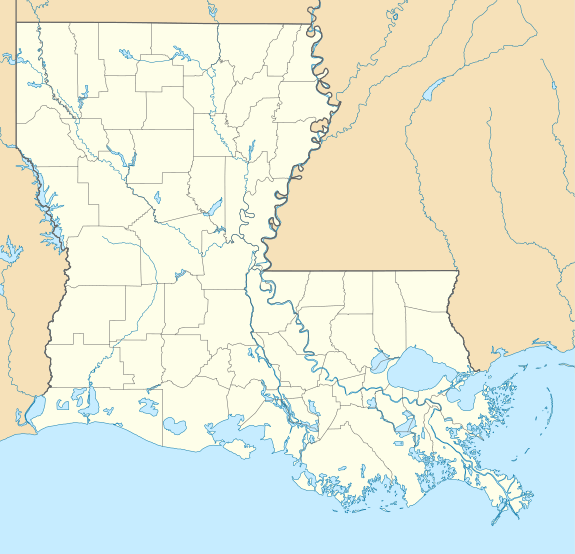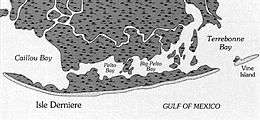Last Island, Louisiana
Last Island (Official name: Isle Dernière, often misspelled as Îsle Dernière, Isle Dernier, L'Îsle Dernière, Île Dernière, etc. ) was a barrier island and a pleasure resort southwest of New Orleans on the Gulf Coast of Louisiana, United States. It was destroyed by the Last Island Hurricane of August 10, 1856. Over 200 people perished in the storm, and the island was left void of vegetation.
Last Island Isle Dernière | |
|---|---|
Remaining portions of Last Island | |
 Last Island Location of Last Island in Louisiana | |
| Coordinates: 29°02′19″N 90°48′15″W | |
| Country | United States |
| State | Louisiana |
| Parish | Terrebonne |
| Area | |
| • Total | 42 sq mi (110 km2) |
| • Land | 3.625 sq mi (9.39 km2) |
| • Water | 38.375 sq mi (99.39 km2) |
| Elevation | 5 ft (2 m) |
| Population (2000) | |
| • Total | 0 |
| • Density | 0.0/sq mi (0.0/km2) |
| Time zone | UTC-6 (CST) |
| • Summer (DST) | UTC-5 (CDT) |
| Area code(s) | 504 |
After the hurricane destroyed the island, it became known in the plural Isles Dernières (Last Islands) in French. The highest points were under 5 ft (1.5 m) of water.

Last Island was south of Dulac, Louisiana, between Lake Pelto, Caillou Bay, and the Gulf of Mexico. The island was originally approximately 25 miles[1] in length before being split in half by the storm; but today only small pieces of several smaller islands remain.
As a result of the hurricane and subsequent tropical storms, Isle Dernière was fragmented into five smaller islands: East, Trinity, Whiskey, Raccoon, and Wine (a.k.a. Vine Island).[2] The western end of the remaining westernmost island is known as Raccoon Point. The remnants of Last Island are now a haven for pelicans and other seabirds. Part of the Isles Dernières chain is the Terrebonne Barrier Islands Refuge, which encompasses three islands, Wine, Whiskey, and Raccoon, and is closed to the public.[3] The closest village is Cocodrie, which is about 13 miles northeast of Trinity Island.
Resort at Last Island
Before the Last Island Hurricane, Isle Dernière (Last Island) was a popular resort where people could enjoy white sand beaches and clearer water, which are not found on the marshy mainland. Last Island was also known for an almost continuous breeze, which would have been welcomed by those escaping the suffocating heat of the mainland. Accommodations included the John Muggah's Ocean House Hotel, and for entertainment there were several gambling establishments and the Captain Dave Muggah's Billiard House.[4] Several hundred yards to the west of the hotel was the settlement known as Last Island Village which consisted of approximately 100 beach homes, some "fine" houses and other temporary summer houses.
Regular steamer service to the island was provided by the Star from Bayou Boeuf. The New Orleans, Opelousas and Great Western Railroad provided a connection to Bayou Boeuf from Algiers, La., a short ride on the Algiers Train Ferry across the Mississippi River from the French Quarter landing at St. Ann Street. Regular railroad fare was $3.50 with half-fare for children and servants.[5] (New Orleanians could take the Algiers passenger ferry.)
Every structure on the island including the hotel, a large, two-story wooden structure of considerable strength, was destroyed.[6] See: 1856 Last Island Hurricane.
References
- Lockhart, John M. "Storm Stories", The Riverside Reader, June 22, 2009, p. 1
- http://www.lighthousefriends.com/light.asp?ID=816
- "Archived copy". Archived from the original on 2012-07-10. Retrieved 2011-07-30.CS1 maint: archived copy as title (link)
- "Archived copy" (PDF). Archived from the original (PDF) on 2009-05-12. Retrieved 2009-06-26.CS1 maint: archived copy as title (link)
- Dixon, Bill (2009). Last Days of Last Island: The Hurricane of 1856, Louisiana’s First Great Storm. Lafayette, LA: University of Louisiana at Lafayette Press. ISBN 1-887366-88-1.
- Lockhart, John M. "Storm Stories", The Riverside Reader, June 22, 2009, p. 4
Further reading
- Dixon, Bill (2009). Last Days of Last Island: The Hurricane of 1856, Louisiana’s First Great Storm. Lafayette, LA: University of Louisiana at Lafayette Press. ISBN 1-887366-88-1.
- Falls, Rose C. (1893). Cheniere Caminada or The Wind Of Death: The Story Of The Storm In Louisiana (Chapter VII. Last Island). New Orleans: Hopkins' Printing Office. pp. 70–71. Retrieved 2009-07-15. NOTE: The book title is incorrectly indexed in Google books
- Hearn, Lafcadio (1889). Chita: A Memory of Last Island (1917 edition). New York: Harper & Brothers Publishers. Retrieved 2009-07-15.
- Island in a Storm: A Rising Sea, a Vanishing Coast, and a Nineteenth-Century Disaster that Warns of a Warmer World, by Abby Sallenger, Public Affairs, Perseus Book Group, NY, 2009. ISBN 1-58648-515-6, ISBN 978-1-58648-515-3
Bibliography
- Last Island, by James M. Sothern, Market$hare Enterprises, 1980.
- Last Days of Last Island, by Bill Dixon, University of Louisiana at Lafayette Press, 2009.
- Island in a Storm, by Abby Sallenger, PublicAffairs, Perseus Books Group, 2009. ISBN 1-58648-515-6, ISBN 978-1-58648-515-3